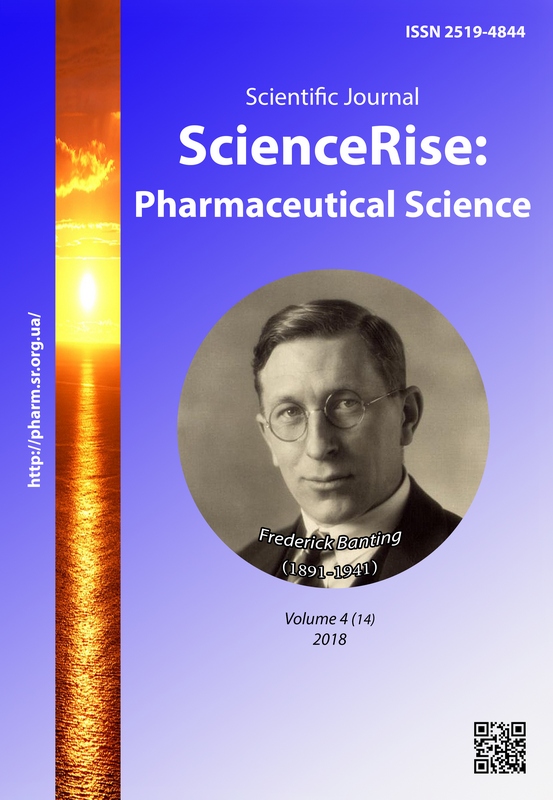Дослідження вільних амінокислот водорозчинного білково-полісахаридного комплексу грибу плевроту черепичастого
DOI:
https://doi.org/10.15587/2519-4852.2018.141412Ключові слова:
Плеврот черепичастий, біологічно активні речовини, амінокислоти, високоефективна рідинна хроматографія, стандартизаціяАнотація
Останнім часом на фармацевтичному ринку України збільшується частка лікарських засобів природного походження. Це пов’язано з тим, що фармакологічний ефект природних субстанцій забезпечує комплекс біологічно активних речовин, що має високу терапевтичну дію та мінімальну кількість побічних реакцій. Тому дослідження хімічного складу та стандартизація природних субстанцій є важливим етапом фармацевтичних досліджень.
Перспективним джерелом отримання активно діючих інгредієнтів є гриб Плеврот черепичастий. Хімічний склад цього гриба представлено великою кількістю біологічно активних речовин, що забезпечують його багатогранне використання в народній медицині.
Мета. Визначення якісного та кількісного складу вільних амінокислот, що входять до складу водорозчинного білково-полісахаридного комплексу (ВБПСК) грибу Плевроту черепичастого.
Методи. Для дослідження діючих субстанцій природного походження найбільш часто використовують фізико-хімічні методи. Це пов’язано з тим, що вони забезпечують високу інформативність, точність, ефективність та відтворюваність. Для аналізу амінокислотного складу ВБПСК грибу Плевроту черепичастого було використано метод високоефективної рідинної хроматографії (ВЕРХ), що є заснованим на розділенні індивідуальних компонентів за рахунок різної адсорбційної здатності.
Результати дослідження. Дослідження амінокислотного складу ВБПСК грибу Плевроту черепичастого показало, що комплекс містить 10 (7 %) вільних амінокислот, серед яких 5 є незамінними. Виявлені амінокислоти є сполуками аліфатичної, гетероциклічної та ароматичної будови. Їх представлено гліцином, аланіном, лейцином, ізолейцином, треоніном, селіном, лізином, аргініном, гістидином та фенілаланіном.
Висновки. В ході експериментальних досліджень було встановлено якісний та кількісний склад вільних амінокислот ВБПСК грибу Плеврот черепичастий. Запропоновано методику визначення та розділення вільних амінокислот методом високоефективної рідинної хроматографії. Отримані результати пропонуються для стандартизації вихідної субстанції в процесі виробництва лікарських препаратів на основі ВБПСК грибу Плевроту черепичастого
Посилання
- Solodovnychenko, N. M., Zhuravlov, M. S., Kovalov, V. M. (2001). Likarska roslynna syrovyna ta fitopreparaty. Kharkiv: Vyd-vo NFAU: Zoloti storinky, 408.
- Georgievskiy, V. P. (Ed.) (2001). Analiticheskaya himiya v sozdanii, standartizacii i kontrole kachestva lekarstvennyh sredstv. Vol. 2. Kharkiv: «NTMT», 474.
- Molitorus, H. P. (1994). Mushrooms in medicine. Folia Microbiol, 39 (2), 91–98.
- Mariappan, S., Vinayagam, S., Durai, M. (2015). Phytochemical screening of bioactive compounds from Pleurotus ostreatus (jacq.fr) kumm-an wild edible mushroom. World Journal of Pharmaceutical Research, 4 (5), 1603–1618.
- Mowsurni, F., Chowdhury, M. (2013). Oyster Mushroom: Biochemical and Medicinal Prospects. Bangladesh Journal of Medical Biochemistry, 3 (1), 23–28. doi: https://doi.org/10.3329/bjmb.v3i1.13804
- TU U 10.8-02010675-001:2017 Kompleks bilkovo-polisakharydnyi.
- Kucherenko, N. V., Martynov, A. V., Demianenko, V. H. (2008). Rozrobka metodyk standartyzatsiyi vodorozchynnoho bilkovo-polisakharydnoho kompleksu, otrymanoho z hryba Pleurotus Ostreatus. Farmatsevtychnyi zhurnal, 1, 92–95.
- Minaieva, V. O. (2013). Khromatohrafichnyi analiz. Cherkasy, 284.
- Neda, I., Vlazan, P., Oana, R., Sfarloaga, P., Grozescu, I., Segneanu, A.-E. (2012). Peptide and amino acids separation and identification from natural products. Analytical Chemistry, 6, 135–146. doi: https://doi.org/10.5772/51619
- Konovalova, E. Yu., Stazhyla, E. N., Lebeda, A. Ph. (2010). Amino acid research of family elaeagnaceae juss. Plants' leaves. Fitoterapiya, 2, 60–64.
- Moran-Palacio, E., Tortoledo-Ortiz, O., Yañez-Farias, G., Zamora-Álvarez, L., Stephens-Camacho, N., Soñanez-Organis, J. et. al. (2014). Determination of amino acids in medicinal plants from Southern Sonora, Mexico. Tropical Journal of Pharmaceutical Research, 13 (4), 601–606. doi: https://doi.org/10.4314/tjpr.v13i4.17
- Rudakov, O. B., Vostrov, I. A., Fedorov, S. V. et. al. (2004). Sputnik hromatografista. Metody zhidkostnoy hromatografii. Voronezh: Vodoley, 528.
- Minazova, G. I. (2010). Highly effective liquid chromatography in the analysis of natural raw material. Bashkirskiy himicheskiy zhurnal, 17 (4), 134–136.
- Syrovaya, A. O., Shapoval, L. G., Makarov, V. A. et. al. (2014). Aminokisloty glazami himikov, farmacevtov, biologov. Vol. 1. Kharkiv: Shchedra sadiba plyus, 228.
- Davies, J. S. (2006). Amino Acids, Peptides and Proteins. Cambridge: The Royal Society of Chemistry, 472.
##submission.downloads##
Опубліковано
Як цитувати
Номер
Розділ
Ліцензія
Авторське право (c) 2018 Boris Varinsry, Nataliia Kucherenko, Olga Kolpakova

Ця робота ліцензується відповідно до Creative Commons Attribution 4.0 International License.
Наше видання використовує положення про авторські права Creative Commons CC BY для журналів відкритого доступу.









